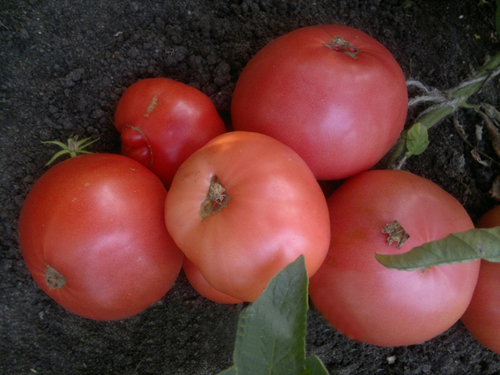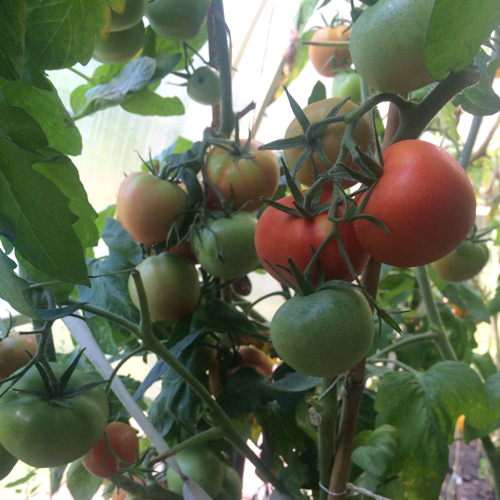Tomato variety Wild rose
Pink tomato lovers are probably familiar with the Wild Rose variety. An application for its registration was submitted in 1997 by Agrofirma Aelita LLC and the Pridnestrovian Research Institute of Agriculture. The novelty was introduced into the State Register of Breeding Achievements in 1999. Open field and unheated film greenhouses approved in all regions. The tomato is recommended for garden plots, home gardens and small farms. Not a hybrid.

Description
The plant belongs to the indeterminate, that is, tall species. Because of this feature, the height of the stem can be 170 cm in the open field, in the greenhouse - more than 2 meters. The stalk is strong, the internodes are not too elongated. The Wild Rose bush looks powerful due to the formation of lateral shoots and good foliage. The leaves are large, of the usual type, petiolate, with a slightly corrugated surface, dark green. The inflorescence is simple. Fruit clusters are formed after 9 leaves. The following brushes are formed after 1, usually 2 leaves. Each cluster has about 6 - 7 ovaries. The peduncle is articulated. The place of attachment of the stalk to the tomato is not wide.
The fruits of the variety are round or flat-round, slightly ribbed, elastic. The ripening tomato initially has a green color and a dark green spot at the base. When ripe, it becomes pink-crimson. The skin is thin, slightly glossy. The pulp of the Wild Rose is fleshy, sugary at the break, juicy, moderately dense, without voids. Seed nests are small, their number is 4 or more. The taste is excellent, the taste is dominated by sweetness, the sourness is barely perceptible. The usual weight of tomatoes is 300 - 350 grams, the maximum weight is 400 grams. Some gardeners have managed to grow 900 gram specimens. 100 grams of pulp contains: dry matter - up to 7%, the amount of sugars - up to 3.7%.

Characteristics
- In terms of ripening, the Wild Rose is rather mid-ripening, as indicated by the originator. From the moment of emergence of seedlings to the beginning of ripening of tomatoes, 110 - 115 days pass. Although the State Register indicates that the variety is early maturing;
- fruiting is extended, begins in July and can last until the very cold;
- yields are good, but with proper care. According to the State Register, up to 6 kg of marketable fruits are removed from 1 square meter, according to other sources - from 3.5 to 5 kg from a bush. On the forums, gardeners complain about low yields (up to 2 kg per plant) under adverse weather conditions when grown in open ground;
- thin skin does not save the tomato from cracking at high humidity;
- the immunity is not bad for a varietal plant - it has a high resistance to the tobacco mosaic virus, but it can suffer from phytophthora;
- there is a lot of controversy about the declared heat resistance, some gardeners note that in the heat, the formation of the ovary stops, because of this, decent gaps are obtained on the stem;
- dry periods Wild rose does not tolerate well;
- to sudden cold snaps and rainy weather, especially when grown in cool regions, the variety is also not very resistant;
- due to the thin skin, the fruits are not very suitable for long-term transportation, but they can be stored for some time, especially if the tomatoes are plucked at the stage of blanche ripeness;
- the purpose of using the fruit is salad. But you can make juices and sauces from the tomato harvest.
Agrotechnics
A wild rose cannot be called unpretentious, although it is not too capricious. Some of the nuances of growing a variety must be taken into account. In the southern regions, sowing seeds directly into the soil is quite appropriate. Although this method is not very relevant due to the high consumption of seeds. The seedling method is more economical and suitable for all regions.For seedlings, seed is sown 60 - 65 days before transplanting into the ground. It is best to calculate the exact dates yourself, taking into account the climatic features of the region. The recommended planting density is 4 plants per square meter. In order for the tomato to show the best result, it is formed into 1 or 2 stems. Although 3 stems are also appropriate, but in a greenhouse. Watering is required uniformly so that the soil is constantly in a moderately moist state. After overdrying the soil, watering must be done very carefully, otherwise overflow can provoke cracking of the fruit. The bush requires an obligatory garter on a trellis or support. Stepping is carried out regularly. The rest of the care, including feeding, weeding and loosening, is normal.
Wild rose is a wonderful variety in taste and color. An early harvest is always appreciated by gardeners, but tomato productivity depends on proper care and weather. Therefore, in cool regions, the variety is preferred to grow indoors. Seeds can be harvested on their own, this will help to avoid cases of misgrading when buying from unscrupulous sellers. The disadvantages include the need for tying and pinching, in addition, the moisture of the soil should be controlled.








